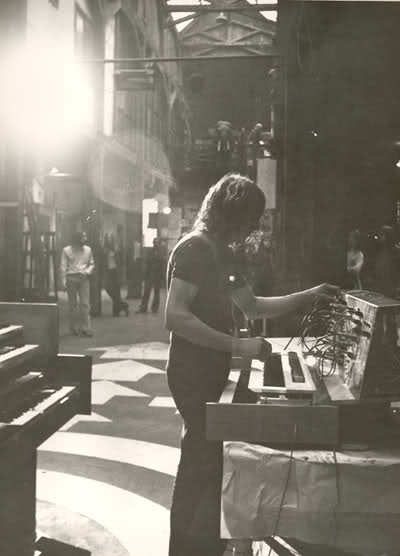The PPG Story
My synthesizer was now essentially made up of the Oscillator, a VCA and an Envelope. I had also built myself a Keyboard from the manual of a "Dr.Boehm" organ building kit. The key contacts were self soldered.
So far this was quite nice but I still wasn't able to produce the typical "moog sounds" with it. At this point I still had no clue of how to get it working. Instead I enriched my synth with a sequencer. To that time the "field-effect transistors" had just come out and were available to people like me. I didn't build the sequencer like one knows it from the moog with all the knobs, but completely electronic by using the field-effect transistors together with condensers for memorizing the pitch value.
 On one of our following gigs, where I had used the sequencer, there was a well known scene musician from Hamburg, Okko Becker. After the gig he came up to me and told me that he had a minimoog which he would love to connect with my sequencer.
On one of our following gigs, where I had used the sequencer, there was a well known scene musician from Hamburg, Okko Becker. After the gig he came up to me and told me that he had a minimoog which he would love to connect with my sequencer.
I told him that I could arrange this but that I would need to take his minimoog with me for a few days, to be able to ajust my sequencer to it.
No sooner said than done.. for the first time in my life I got my hands on a real moog. In that instant the scales fell from my eyes and it was clear that the only element I was missing was the filter.
I tried different circuits from a good electronics handbook, which should make the filter controllable, but the typical moog sound still didn't come out. So I borrowed Okko's moog once again and opened it up to look at how the VCF was built.
I had a weird feeling for a long time, because I knew that the VCF was patent-registered. But one could only build a VCF one way.
The few units which were built by PPG were in low count compared to the quantities of moog. (At the moment I am only talking about the analogue synths, later in the Wave, we built in chips which were licensed on their part)
Mein Synthesizer bestand nun im Wesentlichen aus dem Oscillator, einem VCA und einer Envelope. Ein Keyboard hatte ich mir auch zusammengebastelt - aus einem Orgelmanual von einer "Dr. Böhm"-Bausatzorgel sowie selbst zusammengelöteten Tastenkontakten.
Das war soweit ganz schön, aber die typischen "moog sounds" bekam ich damit noch nicht hin. Ich hatte auch keine Ahnung wie das funktionieren könnte.
Stattdessen bereicherte ich meinen Synth mit einem Sequenzer. Zu der Zeit waren gerade die "Feldeffect Transistoren" erfunden bzw. für Leute wie mich verfügbar. Ich baute mir dann den Sequenzer nicht - wie man das vom moog her kennt - mit den vielen Knöpfen, sondern rein elektronisch, indem ich diese Feldeffect Transistoren zusammen mit Kondensatoren, für die Speicherung der Tonhöhen einsetzte.
Bei einem unserer folgenden Auftritte, bei dem ich den Sequenzer einsetzte, war ein bekannter Hamburger Scene-Musiker anwesend: Okko Becker. Nach dem Auftritt sprach er mich an und erzählte, dass er einen minimoog hätte und gerne meinen Sequenzer damit verbinden würde. Ich sagte, dass ich das vorbereiten könnte und dann seinen minimoog für ein paar Tage mitnehmen müsste, um den Sequenzer anzupassen.
Gesagt, getan... ich bekam also das erstemal einen richtigen moog in die Hände. Da fiel es mir wie Schuppen von den Augen und mir war klar, dass der Filter das Element war, welches mir fehlte.
Ich probierte erstmal verschiedene Schaltungen aus einem guten Elektronik-Lehrbuch aus, die einen Filter steuerbar machen sollten - aber der typische moog-sound kam dabei nicht heraus. Also hab ich mir den moog von Okko nochmal ausgeliehen, habe ihn aufgeschraubt und mir angesehen, wie der VCF aufgebaut ist.
Ich hatte zwar lange Zeit ein mulmiges Gefühl, da ich wusste, dass der VCF patentieret war... aber man kann einen VCF nunmal nur so und nicht anders aufbauen und die wenigen Geräte, die PPG produziert hat, sind im Verhältnis zu den moog-Stückzahlen vernachlässigbar. (Ich rede jetzt nur von den Analog-Synthies - später im Wave wurden fertige Chips eingesetzt, die wohl ihrerseits lizensiert waren).